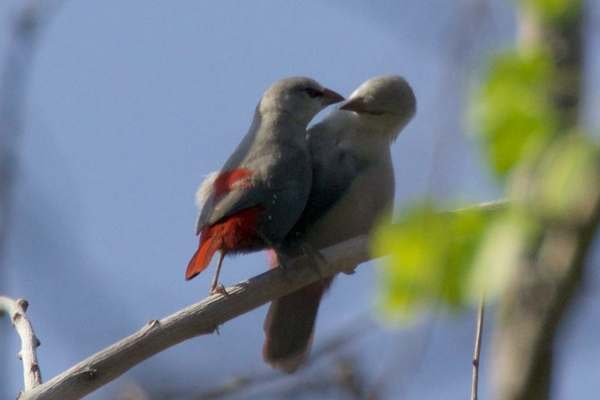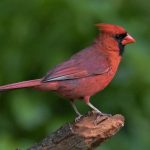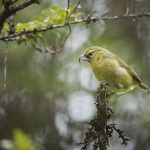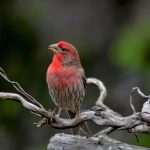Lavender waxbill | image by Paul Lathbury via Flickr | CC BY-SA 2.0
Common Name: Lavender Waxbill
Scientific Name: Glaucestrilda caerulescens| Size | Diet | Range in Hawaii | Status in Hawaii |
|---|---|---|---|
| 4 ½ in. | fine grasses, chickweed, vegetables, fruits, berries, eggs | Big Island and Maui | least concern |
The Lavender waxbill is a species of finch that lives on the Hawaiian islands. They were introduced in the 1960s and are now flourishing on the state’s various islands. These colorful birds add so much life and music to Hawaii’s forests that some people are becoming fascinated by them.
If you are one of those people, keep reading to learn more about these amazing creatures!
Lavender waxbill
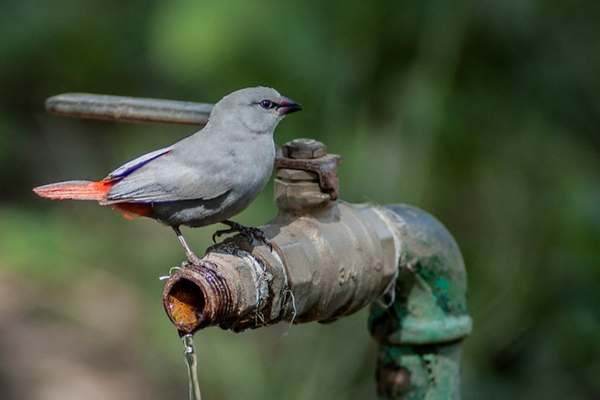
Scientific Name: Estrilda caerulescens
Appearance
The Lavender waxbill is a grayish bird that grows to be about 4.5 inches long and weighs about 10 grams. Both adults are lavender grey with a red back, wings, and tail.
Their bills range in color from red to black, and their feet are gray. When they spread their tails, you can see black stripes.
Males have paler throats and chests, whereas females have dark underpants but much paler bellies than males. Males are also larger than females.
This species’ chicks are the same color as adults but paler. Their red tail coloring is also less vibrant than that of adults.
Diet
The Lavender waxbill’s diet consists of a variety of fruits, seeds, greens, and other live foods. They also consume the nectar and pollen of certain flowers. Worms, fruit flies, and spiders are among the insects they’ll consume.
This bird’s diet varies depending on where it lives. In some areas, it consumes only one type of food, whereas in others, it consumes a variety of foods.
This bird’s diet can also vary depending on the season or time of day when it feeds. For instance, they might favor eating insects during the breeding season or when they have chicks to feed to provide enough nutrients.
Behavioral traits
Lavender waxbills are highly social birds that prefer to live in groups rather than alone. They’re typically observed in flocks or family groups of 6 to 12 birds. Some groups may have 20 – 30 birds.
They can also be seen in their natural habitat with other waxbills. However, when they’re looking for mates during the breeding season, they may be aggressive. This bird’s song is very high-pitched and squeaky, making it stand out among the calls of other finches.
It sounds like “see-see-see-swree,” with the first note being short and high in pitch, and the second being longer, lower in pitch, and much more melodious than the first. The most common call sounds somewhat like “tseep” or “cheep.”
Breeding
The breeding season for these birds is usually during the rainy season. Males court females by carrying nesting materials and moving up and down with their tails angled toward the desired mate. When they’re ready to breed, the male will peck the female’s nape a few times, and the female will respond by crouching and quivering her tail.
Females lay 4 to 6 eggs per season, which both parents incubate for 12 to 15 days. The eggs will hatch after 13 days and will fledge 18 days later.
Habitat
The lavender waxbill prefers grasslands with sandy soil and sparse vegetation. These birds eat insects and seeds that they find on the ground.
You can find these amazing birds nesting in low bushes or grasses, as well as between rocks. They’re not afraid of humans and will live in places such as gardens, fields, and lawns.
Native
This bird species is native to the countries of Africa. Benin, Cameroon, Chad, Ghana, Liberia, Nigeria, Sudan, and Togo are some of the African countries where you can find the Lavender waxbill. It lives in grasslands, open woodlands, and scrublands in this area, but is most commonly found in wetlands in Nigeria.
Hawaii
The Lavender Waxbill is a bird that has been introduced to Hawaii. It was introduced to the islands in the 1960s and has since thrived and become a common sight.
They can now be found in the gardens, parks, and forests of Maui, Hawai’i and Oahu.
Conservation Status
The International Union for Conservation of Nature assessed the Lavender waxbill’s conservation status. It determined that it’s considered as least concern because it has a wide range, no noticeable population decline, and its population size is relatively stable.
Interesting facts
1. Their beaks are red like sealing wax
The name “waxbill” comes from the red color of these birds’ beaks, which resemble the red color of sealing wax.
2. They court by dancing up and down
Females are courted by male lavender waxbills by bringing them a piece of nesting material. They then perform an up-and-down dance until the female acknowledges his suitability as a mate.
3. This bird has a melodious song
The Lavender Waxbill is a brightly colored, melodious bird with a distinct song that is pleasing to the ears. The first part of their melody is short and fast-paced with high-pitched notes, while the second is much longer and more melodious.
4. Lavender waxbills greet each other by bowing
The birds do this by lowering their heads and curving their necks while facing each other. They do it to demonstrate respect, affection, and friendship. This is a normal sight for both sexes.
Frequently asked questions:
What do lavender waxbills eat?
Lavender waxbills are omnivores, meaning they eat both plant and animal material. They eat insects, worms, fruit, nectar, pollen, and seeds.
What do you feed a baby waxbill?
You can feed your waxbill chicks insects such as mealworms or crickets. When feeding waxbill chicks, a diet high in protein is recommended. This will help them to grow strong and healthy.

